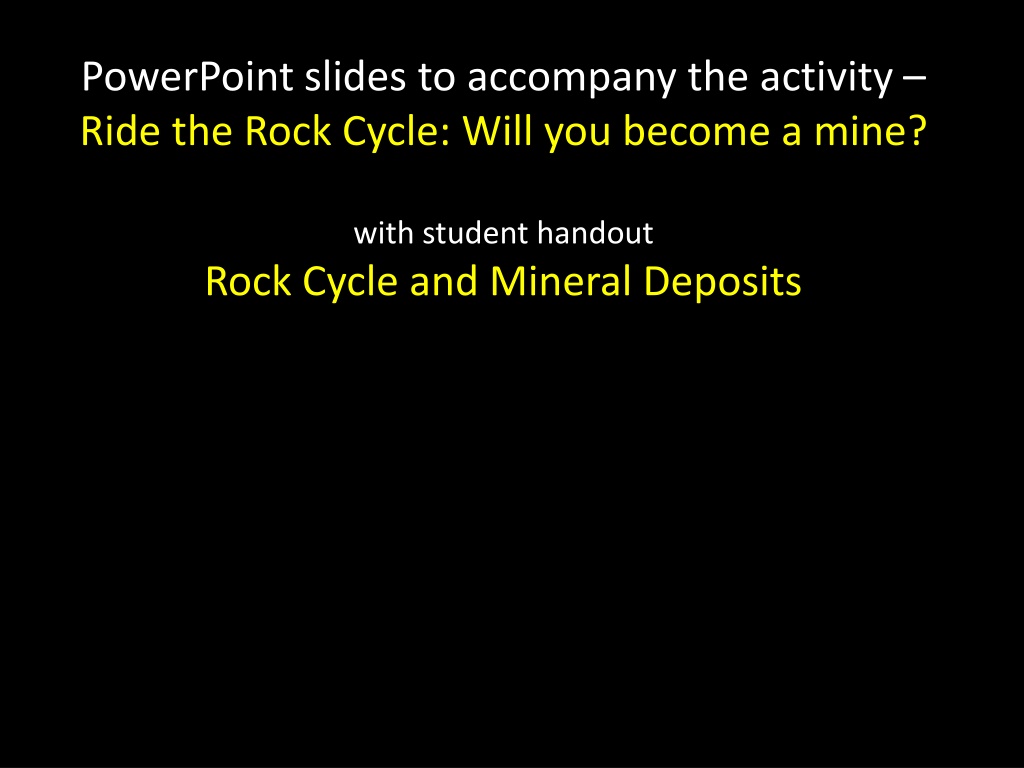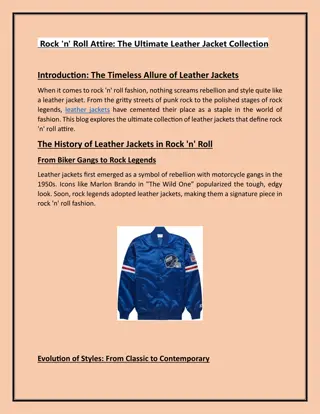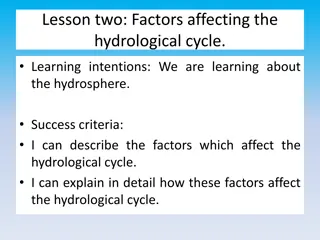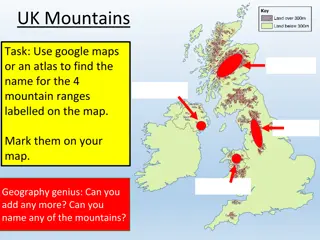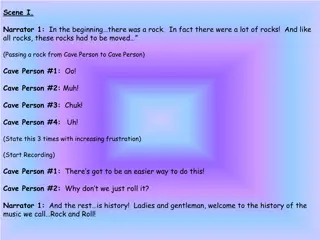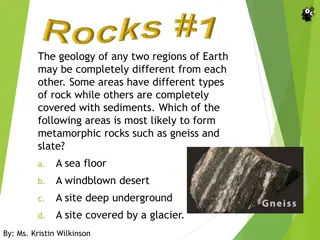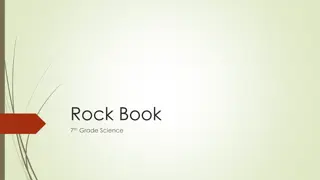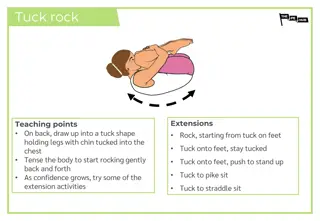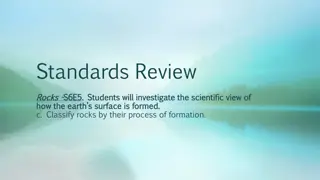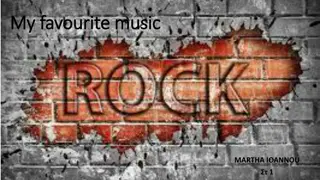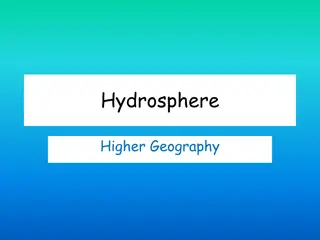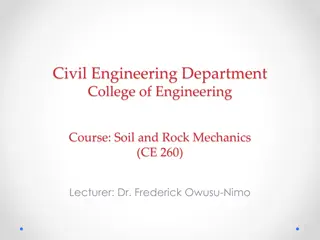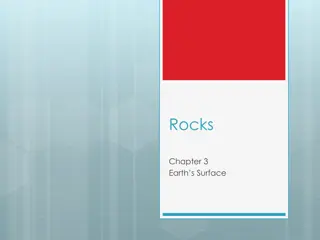Exploring the Intricacies of the Rock Cycle Through Interactive Activities
Dive into the fascinating world of rocks and minerals with the engaging activity "Ride the Rock Cycle: Will you become a mine?" This game-based approach allows students to visualize and comprehend the complexity of the rock cycle, appreciate plate tectonics, understand the rarity of economically valuable mineral deposits, and learn about probability and statistics. The accompanying PowerPoint slides cover topics from weathering and erosion to plate boundaries and primary rock types, highlighting key processes and locations involved in the formation and transformation of rocks and minerals.
Download Presentation

Please find below an Image/Link to download the presentation.
The content on the website is provided AS IS for your information and personal use only. It may not be sold, licensed, or shared on other websites without obtaining consent from the author. Download presentation by click this link. If you encounter any issues during the download, it is possible that the publisher has removed the file from their server.
E N D
Presentation Transcript
PowerPoint slides to accompany the activity Ride the Rock Cycle: Will you become a mine? with student handout Rock Cycle and Mineral Deposits
The purposes of this activity (game) are to: 1. understand and visualize how rocks and minerals change, and that the rock cycle is complex; 2. appreciate that plate tectonics explains many details of the rock cycle; 3. gain insight into how rare the process of forming deposits of economically valuable rocks and minerals can be. 4. learn a bit about probability and statistics.
Rocks are in red. Locations are in green. Constituents are in purple. Processes are in blue.
The Rock Cycle Earth s Surface: Weathering & Erosion Water: Volcanic Rock & Volcano (Extrusive Igneous Rock) River/Lake/Ocean (Dissolution/ Precipitation) Sediments Compaction and Cementation (Clastic) Sedimentary Rock Intrusive Igneous Rock (Chemical) High Temperature and Pressure Cooling and Crystallizing Metamorphic Rock Magma Melting
The Earths crust is broken into tectonic plates. Red dots = active volcanoes. Black lines = plate boundaries
Convection of heat from the Earths interior drives plate tectonics.
The primary plate boundaries are ocean ridges (divergent boundaries), subduction zones (convergent boundaries), and transform faults.
The primary rock types (sedimentary, metamorphic, and both intrusive and extrusive igneous rocks/volcanic rocks) are found at specific locations in plate-tectonic settings.
Ore deposits also are found at specific locations in plate-tectonic settings.
Imagine yourself as an atom in an initial rock. Start at either the Sedimentary Rock, Metamorphic Rock, Intrusive Igneous Rock, or Extrusive Igneous/Volcanic Rock station. Roll dice to determine how long you stay in that rock, then roll again to determine where you go next either stay where you are or move to another station. Fill out the Rock- cycle data sheet after each roll of the dice. Continue until you have been in three rocks (moved from the initial rock to a second rock, then to a third rock).Fill out the Rock-cycle data sheet after each roll of the dice. After you have rolled the dice to determine you long you were in the third rock, fill out the Geologic history sheet.
After you have rolled the dice to determine you long you were in the third rock, fill out the Geologic history sheet. Answer the questions in the Interpretations section of the worksheet.
Next Generation Science Standards. The most applicable standards are: High School - History of Earth HS-ESS2-1. Students who demonstrate understanding can develop a model to illustrate how Earth s internal and surface processes operate at different spatial and temporal scales to form continental and ocean-floor features. High School Science and Engineering Practices Analyzing and Interpreting Data. Apply concepts of statistics and probability to scientific and engineering questions and problems, using digital tools when feasible. Middle School Earth s Systems MS-ESS3-1. Students who demonstrate understanding can construct a scientific explanation based on evidence for how the uneven distribution of Earth s mineral, energy, and groundwater resources are the result of past and current geoscience processes. Middle School Earth s Systems MS-ESS2-1. Students who demonstrate understanding can develop a model to describe the cycling of Earth s materials and the flow of energy that drives this process. Disciplinary Core Ideas ESS2.A (Earth Materials and Systems), ESS2.B (Plate Tectonics and Large-Scale Interactions), ESS2.C (The Roles of Water in Earth s Surface Processes), ESS3.A (Natural Resources).
Ride the Rock Cycle Grades 6-12 This classroom activity is a dice game that helps students understand how rocks change with geologic time and how economic concentrations of minerals and rocks (ores) are related to common rocks. Teams of students follow an atom in an initial rock through its history. They collect and interpret numerical data. They learn that the path the atom takes may be complicated and that ore deposits are rare. Although the only math skill that is required is addition, advanced students learn to use probabilities to solve problems.
